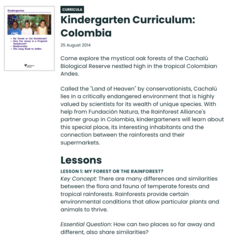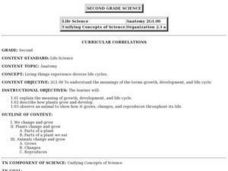Curated OER
Six Plant Parts
Young scholars create a harvest burrito out of fruit, flowers, roots, stems, and more. In this plants lesson plan, students go out into the garden and identify the 6 plant parts.
Curated OER
Measuring the Effects of Gravistimulation on Plants
Students conduct an experiment to determine if a plant's response to gravity is affected by different angles of plant orientation.
Curated OER
Observing the Growth of a Maize Root
Learners conduct an experiment in order to observe the typical downward growth of a maize root. They become familiar with the root's growth patterns to use as a control for comparison in other experiments.
Curated OER
Root Caps and the Effect on Gravity Sensing
Students conduct an experiment to determine how the absence of a root cap affects a plant's ability to sense gravity. They make comparisons between capped and decapped roots.
Curated OER
Corn Harvest
Learners read Corn Belt Harvest and write sentences about corn's uses. They visit a cornfield and a grain elevator or have guest speakers come to class. They design posters about harvesting or processing corn into grain.
Curated OER
Red Leaf, Yellow Leaf
Students discuss the differences between a storybook and an information book. Students use various materials found in nature to make a nature collage. Students make a nature dictionary using pictures and their own definitions from the...
Curated OER
Comparing Roots After Rotation of Ninety Degrees
Students conduct an experiment and use different measurements of a single root to illustrate the mechanism of plant movement.
Curated OER
Air Pollution
Students seek solutions to environmental problems. They discover how to conserve and protect natural resources. They examine the role of acid rain on plants and discover how to filter pollutants.
Curated OER
Edible and Medicinal Plants: Field Trip Guide
Though it's designed to guide a field trip to the New York Botanical Garden, you could take resource like this one to a local park, wilderness area, school garden, or even a weedy empty lot. Middle schoolers identify plant parts and...
Curated OER
Making Pretzels
Young scholars explore how people use plants for food. They use pretzels to see how wheat can be turned into food.
Curated OER
My Forest or the Rainforest?
Students explore the flora and fauna of temperate forests and rainforests. They examine the environmental conditions that allow certain plants and animals to live in the rainforest.
Curated OER
Do They Grow Up or Down?
Students keep a garden journal after planting a garden and discuss environmental stresses put upon the garden for growth. In this garden lesson plan, students plant the plants differently from one another and observe the outcomes.
Curated OER
Stella the Swan
Students study the similarities and differences between ducks, geese, and swans. They tell the story about how water fowl adapt to life in water using props.
Curated OER
Prairie Predator and Prey
Fifth graders brainstorm a list of animals that live on the prairie, and classify them as predators and prey. They conduct interviews where they ask the animals what they need to look out for to sustain life on the prairie.
Curated OER
Bats, Bees, Birds, and Blossoms
Youngsters use a paper bee to pollinate two paper flowers. They use hole-punch dots as pollen. Older learners dissect flowers and name the structures involved in pollination. The handouts mentioned in the lesson plan are not included, so...
Curated OER
Variations in Growth and Reproduction of Recently Transplanted Prairie Forbes and Grasses
students recognize and name prairie plants without the use of a key. they determine that prairie plants have different life cycles that affect their rate of growth and reproduction
Curated OER
Describe Environmental Interrelationships
Students describe environmental interrelationships using list of criteria. They are able to explain organism interaction, based on definitions provided. Also, students can use references and worksheets, to describe effects of pollution...
Curated OER
Habitats: must live with them....cannot live without them.
Students conduct an internet study regarding habitat, ecosystem, biome and the region they live in. They observe the habitat by visiting a State Park and observing the organisms in their habitat. In addition, they create their own...
Curated OER
What is Logging?
Future forestry fanatics absorb information about the impact of the logging industry and then answer ten questions. Everything is included on one webpage, so consider having learners write out their answers on a separate piece of paper....
Curated OER
Animals A to Z: Turkey
For this turkey worksheet, 3rd graders will add pages to their "animal books." Students will read 10 facts to gain an understanding of a turkey and its particular attributes.
Curated OER
Native Beauty
Students plant wild flowers and maintain their garden. In this wild flowers lesson plan, students pick and prepare a gardening site, plant wild flowers, and maintain it everyday.
Curated OER
Plant Diversity and Distribution
Learners construct a defined plot on school grounds and observed patterns in plant life. They count trees, shrubs, cacti and record on a data sheet. They compare data and generate a plant diversity overlook for their school.
Curated OER
Living Things Experience Diverse Life Cycles
Second graders will study and explain the meaning of growth, development, and life cycle. They describe how plants grow and develop and observe an animal to show how it grows, changes, and reproduces throughout its life.
Curated OER
In the Company of Wild Butterflies
Learners discover the life cycle of a butterfly and explain the different stages. For this exploratory lesson students watch a video and create insect art and they will get an opportunity to view live specimens of butterflies.

























